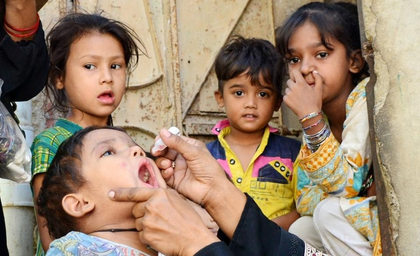Poliovirus detected in sewage samples from seven districts in Pakistan
By IANS | Updated: June 21, 2025 16:33 IST2025-06-21T16:28:34+5:302025-06-21T16:33:53+5:30
Islamabad, June 21 Wild poliovirus type 1 (WPV1) has been detected in environmental samples collected from seven districts ...

Poliovirus detected in sewage samples from seven districts in Pakistan
Islamabad, June 21 Wild poliovirus type 1 (WPV1) has been detected in environmental samples collected from seven districts across Pakistan, the National Institute of Health (NIH) said in a report on Saturday.
According to the Regional Reference Laboratory for Polio Eradication at the NIH in Islamabad, the samples were collected between May 8 and May 23 as part of Pakistan's ongoing environmental surveillance programme.
Sewage samples from Gwadar and Quetta in southwest Balochistan province, Rawalpindi in eastern Punjab province, South Waziristan Upper and South Waziristan Lower in northwest Khyber Pakhtunkhwa province, and Larkana and Mirpur Khas in southern Sindh province tested positive for WPV1, the report said.
Samples from Lahore in Punjab province and Pishin in Balochistan province tested negative, it added.
The Pakistan Polio Eradication Programme has conducted three nationwide immunisation campaigns in 2025, reaching over 45 million children under the age of five with the support of more than 400,000 frontline workers, according to health authorities.
The programme has implemented a rigorous vaccination strategy since September 2024, contributing to a steady decline in polio cases and positive environmental samples nationwide, Xinhua news agency reported.
Pakistan has reported 12 new cases of poliovirus since the start of the year 2025, according to the programme.
Health officials urged all parents and caregivers to ensure their children receive polio drops during every campaign, emphasising that repeated vaccination is the only effective way to protect children from the debilitating disease.
Wild poliovirus type 1 (WPV1) is the only naturally occurring strain of poliovirus still circulating globally. It is a highly infectious virus transmitted through the fecal-oral route, primarily affecting children under five, and can cause paralysis. While there is no cure, immunisation with the polio vaccine can prevent the disease. WPV1 remains endemic in Afghanistan and Pakistan, with the WHO reporting a recent outbreak in southeastern Africa.
The Global Polio Eradication Initiative (GPEI) has been working to eradicate polio since 1988, achieving significant progress in reducing the number of cases by over 99.99 per cent.
Disclaimer: This post has been auto-published from an agency feed without any modifications to the text and has not been reviewed by an editor
Open in app